The Nunchaku
Welcome to American Nunchaku Co. We make handmade traditional professional nunchucks (nunchaku) right here in the United States. We have a wide variety to choose from. Check out our main shop and shop favorites pages to start. All our sets are made to order from domestic and exotic hardwoods. If you have any questions please feel free to contact us, we are happy to help. Don’t feed the import machine, buy American. We use all materials’ and supplies made in the USA…
-
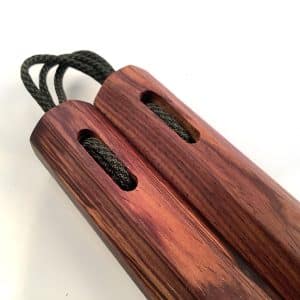 Cocobolo Nunchaku 2025-506$240.00
Cocobolo Nunchaku 2025-506$240.00 -
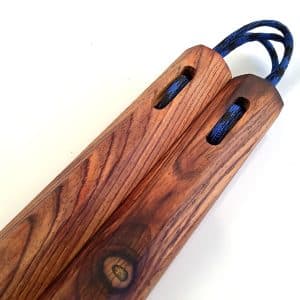 Cocobolo Nunchaku 2025-505$240.00
Cocobolo Nunchaku 2025-505$240.00 -
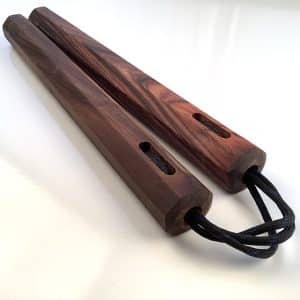 Cocobolo Nunchaku 2025-503$220.00
Cocobolo Nunchaku 2025-503$220.00 -
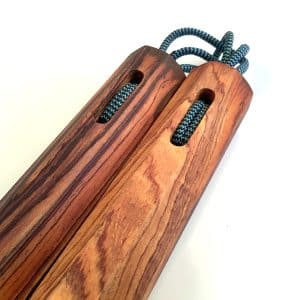 Cocobolo Nunchaku 2025-502$240.00
Cocobolo Nunchaku 2025-502$240.00 -
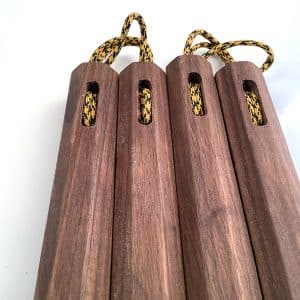 American Black Walnut Nunchaku Slim Long Matched Set$168.00
American Black Walnut Nunchaku Slim Long Matched Set$168.00 -
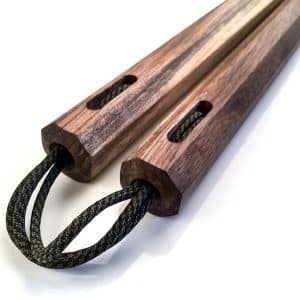 American Black Walnut Nunchaku Slim Long$79.00
American Black Walnut Nunchaku Slim Long$79.00 -
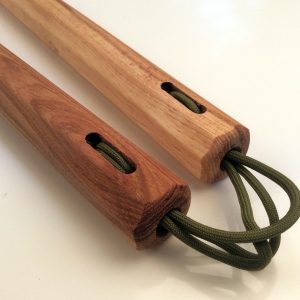 Hickory Nunchaku Slim$85.00
Hickory Nunchaku Slim$85.00 -
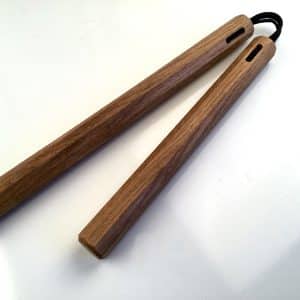 White Oak Uneven Sectional$69.00
White Oak Uneven Sectional$69.00 -
 American Black Walnut Nunchaku Slim$74.00
American Black Walnut Nunchaku Slim$74.00 -
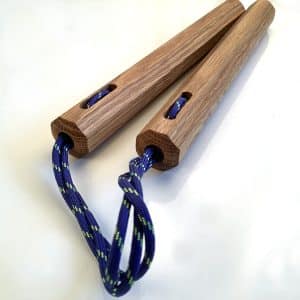 Ukrainian Speed Nunchaku$48.00
Ukrainian Speed Nunchaku$48.00
Formal Styles
The professional nunchucks nunchaku is most commonly used in Okinawan kobudō and karate, but it is also used in eskrima (more accurately, the Tabak-Toyok, a similar though distinct Philippine weapon, is used, as opposed to the Okinawan nunchaku), and in Korean hapkido. Its application is different in each style. The traditional Okinawan forms use the sticks primarily to grip and lock. Filipino martial artists use it much the same way they would wield a stick—striking is given precedence. Korean systems combine offensive and defensive moves, so both locks and strikes are taught. Nunchaku is often the first weapon wielded by a student, to teach self-restraint and posture, as the weapon is liable to hit the wielder more than the opponent if not used properly.
The Nunchaku is usually wielded in one hand, but it can also be paired. It can be whirled around, using its hardened handles for blunt force, as well as wrapping its chain around an attacking weapon to immobilize or disarm an opponent. Nunchaku training has been noted to increase hand speed, improve posture, and condition the hands of the practitioner. Therefore, it makes a useful training weapon.
There are some disciplines that combine nunchaku with unarmed techniques:
- Mouhébong Taekwondo combines Korean nunchaku with taekwondo.
- Nunch-Boxing combines nunchaku with kicking and punching techniques. Nunch-Boxing itself is part of the broader discipline Nenbushi.
- Nunchaku en savate combines savate techniques with the nunchaku.
Free Styles
Freestyle nunchaku is a modern style of performance art using nunchaku as a visual tool, rather than as a weapon. With the growing prevalence of the Internet, the availability of nunchaku has greatly increased. In combination with the popularity of other video sharing sites, many people have become interested in learning how to use the weapons for freestyle displays. Freestyle is one discipline of competition held by the World Nunchaku Association. Some modern martial arts teach the use of nunchaku, as it may help students improve their reflexes, hand control, and other skills.
-
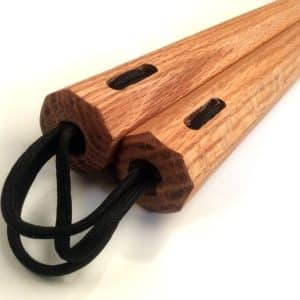 Red Oak Nunchaku$42.00
Red Oak Nunchaku$42.00 -
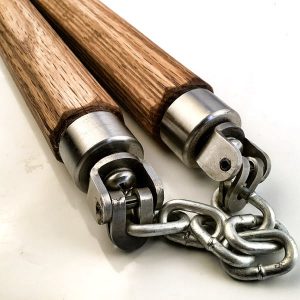 Red Oak Straight Octagon Chain linked Nunchaku$93.00
Red Oak Straight Octagon Chain linked Nunchaku$93.00 -
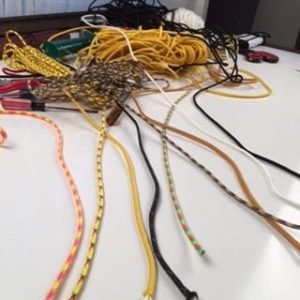 Nunchaku String Pack$5.99
Nunchaku String Pack$5.99 -
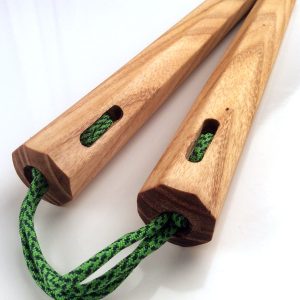 Paulownia Trainer Nunchaku$39.00
Paulownia Trainer Nunchaku$39.00 -
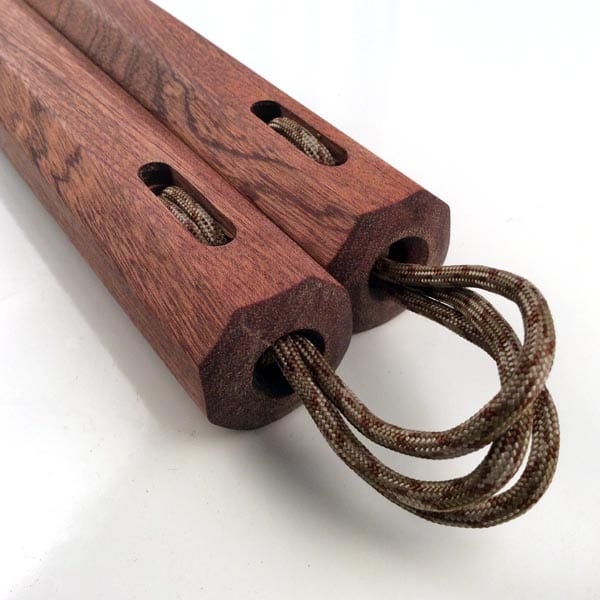 Sapele Nunchaku$49.00
Sapele Nunchaku$49.00 -
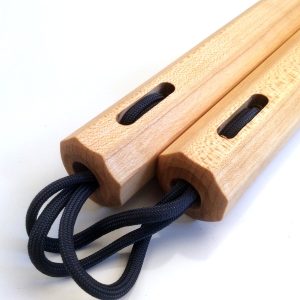 Hard Maple Nunchaku$49.00
Hard Maple Nunchaku$49.00 -
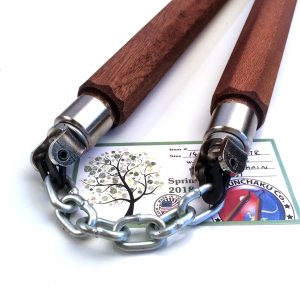 Sapele Universal Chain Nunchaku$103.00
Sapele Universal Chain Nunchaku$103.00 -
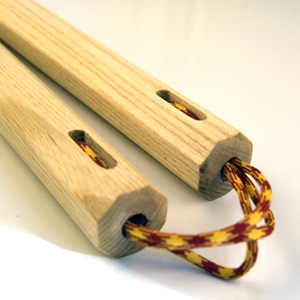 White Ash Nunchaku$43.00
White Ash Nunchaku$43.00 -
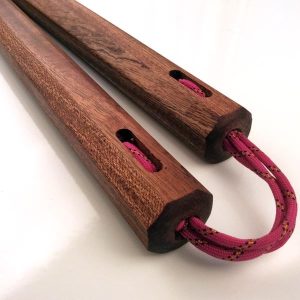 Sapele Slim Nunchaku$49.00
Sapele Slim Nunchaku$49.00 -
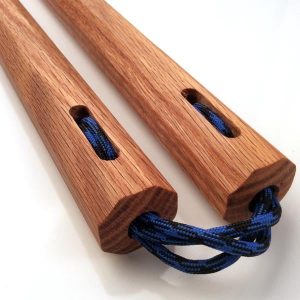 Red Oak Nunchaku Straight Slim$42.00
Red Oak Nunchaku Straight Slim$42.00
Sporting Associations
Since the 1980s, there have been various international sporting associations that organize the use of nunchaku as a contact sport. Current associations usually hold “semi-contact” fights, where severe strikes are prohibited, as opposed to “contact” fights. “Full-Nunch” matches, on the other hand, are limitation-free on the severity of strikes and knockout is permissible.
- North American Nunchaku Association (NANA): Founded in 2003 in California by Sensei Chris Pellitteri, NANA teaches all aspects of the nunchaku, traditional and free-style, single and double.
- World Amateur Nunchaku Organization (WANO): Founded by Pascal Verhille in France in 1988.
- Fédération Internationale de Nunchaku de Combat et Artistique (FINCA): Founded by Raphaël Schmitz in France in 1992 as a merger of disbanded associations WANO and FFNS (Fédération Française de Nunchaku Sportif). Its current name is Fédération Internationale de Nunchaku, Combat complet et Arts martiaux modernes et affinitaires (FINCA). A fight with FINCA rules lasts two rounds of two minutes. There is no need for changing either the nunchaku branch or the hand before hitting, just a correct recuperation. There are no stops during the fight, except for loss, lifting, or penalties.
- World Safety Nunchaku Organization (WSNO) : Safety Nunchaku Grandmaster Soshihan S. Kothandan, India’s Senior most Shito-ryu Karate exponent who got trained under many world level renowned Grand masters in Martial Arts, has gained rich technical expertise in that domain by his passion towards the Art, and he has achieved many milestones in Karate field particularly in Shito-ryu Karate from the past 46 years. He started researching in Safety Nunchaku from 1991 onward. He founded and presented Safety Nunchaku for the first time in front of the general public and Honorable Ministers of Tamil Nadu, India on 28.08.2005. On this day, Safety Nunchaku, Kata, Team Kata, Kumite, Team Kumite, Own style, Stand Target, Moving Target and other new techniques were demonstrated. This research is being continued by means of meeting experts from different parts of the world and sharing their view on Safety Nunchaku as a game and as a Martial art. Finally, 02-08-2015 he had introduced Safety Nunchaku in front of VIP’s, and General Public & released website (www.worldsafetynunchaku.org), demonstrated KATA’s and gave Black Belt to 1st Batch who got training more than two years during his research period. With his vast knowledge, experience and hard work he has introduced and dedicated first time in the Martial Art field “World Standard 16 unique Katas” in the field of Safety Nunchaku. If a person know the proper names of the techniques, correct method of practicing such techniques and most important is where to apply such techniques and what circumstance to apply those techniques then he will do very well in real life under critical situations where his safety is prime concern. By keeping those very important facts in mind, he has framed Katas in Safety Nunchaku in a simple and elegant way where a common people can get into interest to practice and understand the nuances of each techniques.He has also followed some unique methodology to name “World Standard 16 Unique KATAs” in Safety Nunchaku. In general Japanese, when they design a Kata, they gave their names or their master names. But, In Safety Nunchaku, Grandmaster Soshihan S.Kothandan had given names Single chaku “World Standard 16 Unique Katas ” to the patriots-freedom fighters, who made the country to proud globally, People who made proud India in Martial Arts and aid citizens to spread the Art throughout the country and People who supported, encouraged Soshihan in the Karate domain and considered his growth and success as a growth of Martial Art. Safety Nunchaku Grandmaster Soshihan S. Kothandan to insist that fact to future generation to remember those legends in the Name of KATA in near future. Also he categorized the above Unique katas as Origin Katas, Fundamental Katas & Superior Katas (8). He also manufactured with foam and foam rubber Safety Nunchaku cheaper, different colors and different sizes to use all ages of public.
- World Nunchaku Association (WNA): Founded by Milco Lambrecht in the Netherlands in 1996. WNA uses yellow and black plastic weight-balanced training nunchaku and protective headgear. They have their own belt color system, in which participants earn color stripes on the belt, instead of fully colored belts. One side of the belt is yellow and the other black, so that in a competition, opponents may be distinguished by the visible side of the belt. WNA fight rules correspond to the kumite subsection of Nunchaku-do discipline. It is a two-minutes “touch fight,” in which technical abilities are very important. After each scored point, the fight stops and the fighters take back their starting position.
- International Techdo Nunchaku Association (ITNA): Founded by Daniel Althaus in Switzerland in 2006. ITNA rules fights last two rounds lasting 2:30. There are no stops during the round, except for loss, lifting, or penalties. Between two strikes, the fighter has to change hand and nunchaku branch before hitting again, except if he blocks.
